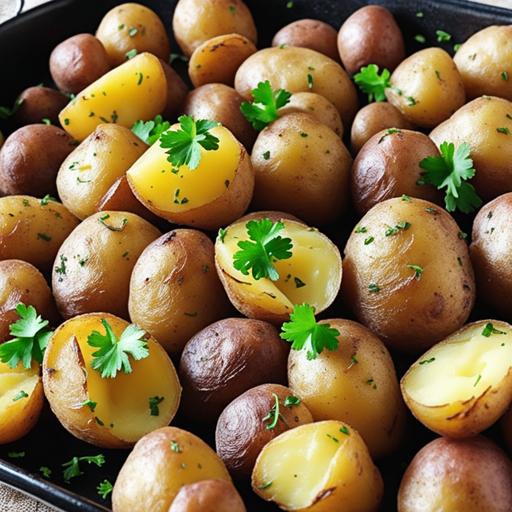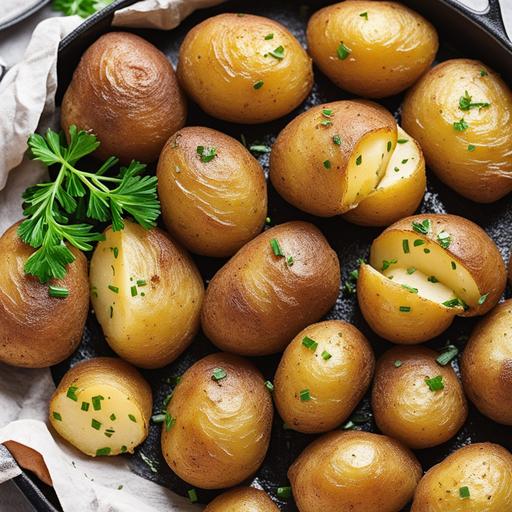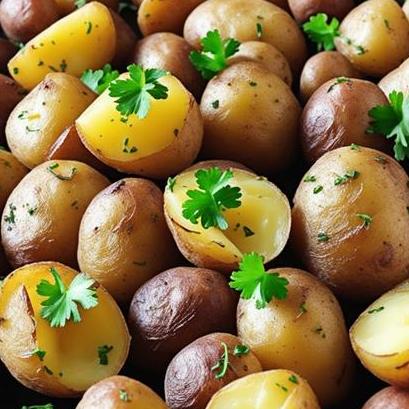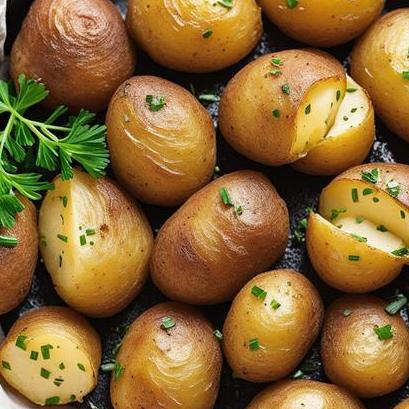
New Potatoes Oven Recipe: A Comprehensive Guide
Potatoes are one of the most versatile and beloved vegetables worldwide, offering a wide range of culinary possibilities. Among the many ways to prepare them, oven-roasting is a particularly popular method that brings out their natural flavors and textures. In this article, we’ll delve into the art and science of cooking new potatoes in an oven, exploring the intricacies of ingredient selection, preparation techniques, optimal cooking temperatures, and timing. By the end, you’ll have a comprehensive understanding of how to create a delicious and satisfying new potatoes oven recipe that’s sure to impress your taste buds and those of your guests.
Food Science Of Cooking New Potatoes In An Oven
Understanding the science behind cooking new potatoes in an oven is essential for achieving the perfect balance of texture and flavor. When potatoes are exposed to dry heat in an oven, several chemical reactions occur that transform their starches and sugars, resulting in a desirable caramelization and crispness on the outside while maintaining a soft and creamy interior.
The main chemical reactions that take place during oven-roasting include:
-
Maillard Reaction: This complex chemical reaction occurs between amino acids and reducing sugars when exposed to heat, resulting in the browning of foods and the development of rich, savory flavors. In the case of new potatoes, the Maillard reaction contributes to the formation of a golden-brown crust on the exterior of the potatoes, enhancing their overall flavor profile.
-
Starch Gelatinization: As the potatoes heat up in the oven, the starch granules within them absorb moisture and swell, undergoing a process known as gelatinization. This process helps to soften the potatoes’ texture and create a creamy interior, making them tender and delicious.
-
Evaporation: As the potatoes roast in the oven, moisture evaporates from their surface, leading to dehydration and the concentration of flavors. This evaporation also plays a role in the development of a crispy exterior, adding texture to the finished dish.
By understanding these fundamental food science principles, you can manipulate various factors such as temperature, cooking time, and ingredient selection to achieve the desired results when roasting new potatoes in the oven.
Choosing Ingredients
The quality of ingredients used in any recipe can significantly impact the final outcome, and this holds true for oven-roasted new potatoes as well. When selecting potatoes for this dish, opt for small, young potatoes known as new potatoes. These potatoes have thin skins, a waxy texture, and a subtly sweet flavor, making them ideal for roasting.
Additionally, consider the following factors when choosing ingredients:
-
Potato Variety: While any variety of new potatoes can be used for this recipe, some popular options include fingerling potatoes, baby red potatoes, or Yukon Gold potatoes. Each variety offers slightly different flavors and textures, so feel free to experiment to find your favorite.
-
Fresh Herbs: Fresh herbs such as rosemary, thyme, and parsley can add depth and aroma to your roasted potatoes. Choose herbs that complement the other flavors in your dish and consider mixing and matching for a more complex flavor profile.
-
Seasonings: Salt, pepper, and olive oil are essential seasonings for roasted potatoes. Opt for high-quality sea salt and freshly ground black pepper to enhance the potatoes’ natural flavors, and use a good quality olive oil for roasting to add richness and moisture.
By carefully selecting high-quality ingredients, you can elevate the flavor and texture of your oven-roasted new potatoes, creating a dish that’s both delicious and satisfying.
Preparing Ingredients

Proper preparation of the ingredients is key to ensuring that your oven-roasted new potatoes turn out perfectly every time. Follow these steps to prepare your potatoes for roasting:
-
Wash the Potatoes: Start by washing the new potatoes under cold running water to remove any dirt or debris. Use a vegetable brush to scrub the skins gently, if necessary, but be careful not to damage the delicate skin of the potatoes.
-
Trim and Halve the Potatoes: Once the potatoes are clean, trim any blemishes or imperfections from the skins using a paring knife. Then, cut the potatoes in half lengthwise to expose more surface area for caramelization during roasting.
-
Season the Potatoes: Place the halved potatoes in a large mixing bowl and drizzle them with olive oil, ensuring that each potato is evenly coated. Season generously with salt, pepper, and any additional herbs or spices of your choice, and toss the potatoes gently to distribute the seasonings evenly.
-
Prepare the Herbs: If using fresh herbs, wash and chop them finely, then sprinkle them over the seasoned potatoes. Alternatively, you can place whole sprigs of herbs on top of the potatoes for a more rustic presentation.
-
Preheat the Oven: Preheat your oven to the optimal temperature for roasting potatoes, as discussed in the next section.
By following these preparation steps, you’ll ensure that your new potatoes are evenly seasoned and coated with oil, resulting in a deliciously flavorful and tender dish.
Optimal Oven Cooking Temperature & Timing
Achieving the perfect balance of crispiness and tenderness when roasting new potatoes in the oven requires careful attention to temperature and cooking time. While the exact temperature and timing may vary depending on your preferences and the specific characteristics of your oven, the following guidelines will help you achieve optimal results:
-
Temperature: Preheat your oven to 400°F (200°C) for perfectly roasted new potatoes. This temperature allows the potatoes to cook evenly and develop a golden-brown crust without overcooking or burning.
-
Cooking Time: Roast the potatoes in the preheated oven for approximately 25-30 minutes, or until they are golden brown and fork-tender. To test for doneness, insert a fork into the thickest part of a potato – it should slide in easily with little resistance.
-
Turning the Potatoes: To ensure even cooking and browning, turn the potatoes halfway through the cooking time using a spatula or tongs. This will help to promote uniform caramelization and crispness on all sides of the potatoes.
-
Additional Tips: If you prefer your potatoes to be extra crispy, you can increase the oven temperature to 425°F (220°C) during the last 5-10 minutes of cooking. Keep a close eye on the potatoes to prevent them from burning, as higher temperatures can cause them to cook more quickly.
By following these temperature and timing guidelines, you’ll be able to achieve perfectly roasted new potatoes with a crispy exterior and tender interior, every time.
New Potatoes Oven Recipe
Now that you understand the science behind cooking new potatoes in an oven and have learned how to select and prepare your ingredients, it’s time to put it all together with a delicious oven-roasted new potatoes recipe. Follow the steps below to create a mouthwatering dish that’s sure to impress:
Ingredients
- 2 pounds (about 900g) new potatoes, halved lengthwise
- 2-3 tablespoons olive oil
- Salt and pepper, to taste
- 2-3 cloves garlic, minced (optional)
- Fresh herbs such as rosemary or thyme, chopped (optional)
Instructions
-
Preheat your oven to 400°F (200°C) and line a baking sheet with parchment paper or aluminum foil for easy cleanup.
-
In a large mixing bowl, combine the halved new potatoes, olive oil, salt, pepper, and minced garlic, if using. Toss the potatoes gently to coat them evenly with the seasonings.
-
Arrange the seasoned potatoes in a single layer on the prepared baking sheet, cut side down, ensuring that they are not overcrowded.
-
Place the baking sheet in the preheated oven and roast the potatoes for 25-30 minutes, turning them halfway through the cooking time, until they are golden brown and fork-tender.
-
Once the potatoes are cooked through and crispy on the outside, remove them from the oven and transfer them to a serving platter.
-
Garnish the roasted potatoes with freshly chopped herbs, if desired, and serve hot as a delicious side dish or appetizer.
Enjoy your oven-roasted new potatoes alongside your favorite main course or as a tasty snack on their own. These flavorful and tender potatoes are sure to be a hit with family and friends alike.
Oven-roasted new potatoes are a simple yet delicious dish that highlights the natural flavors and textures of this versatile vegetable. By understanding the science behind cooking potatoes in an oven and following the steps outlined in this article, you can create perfectly roasted potatoes that are crispy on the outside and tender on the inside, every time. Whether served as a side dish or enjoyed on their own, these flavorful potatoes are sure to become a favorite in your culinary repertoire. So gather your ingredients, preheat your oven, and get ready to savor the irresistible taste of homemade oven-roasted new potatoes.
Doneness Checks

New potatoes, also known as baby potatoes, are young potatoes harvested before they reach maturity. They have a thin, delicate skin and a tender, creamy texture that makes them ideal for roasting. When roasted in the oven, new potatoes develop a golden, crispy exterior while remaining soft and buttery on the inside. This simple yet flavorful dish can be served as a side dish or even as a main course when paired with other ingredients.
To begin, let’s gather our ingredients:
- New potatoes (choose small, firm ones for best results)
- Olive oil or melted butter
- Salt and pepper
- Herbs and spices (optional, for additional flavor)
Now, let’s move on to the steps involved in preparing and roasting the potatoes to perfection.
Achieving the perfect level of doneness is crucial when roasting new potatoes. Undercooked potatoes will be hard and unpleasant to eat, while overcooked potatoes may turn mushy or burnt. Here are some methods for checking the doneness of your roasted potatoes:
Visual Inspection
One of the simplest ways to check if your potatoes are done is to visually inspect them. They should have a golden brown color on the outside and appear tender when pierced with a fork or knife.
Texture Test
Another method is to test the texture of the potatoes. Use a fork to gently press into a potato. If it yields easily and feels soft and creamy inside, it’s likely done. However, if there is resistance or the potato feels firm, it may need more time in the oven.
Taste Test
Finally, the most foolproof way to check for doneness is to taste a potato. Take one from the oven, allow it to cool slightly, and then taste it. It should be tender and flavorful, with a hint of crispiness on the outside.
Undercooking
Undercooking can occur if the potatoes are not roasted for long enough or at a high enough temperature. Signs of undercooked potatoes include a firm texture and a lack of golden brown color on the outside. If you find that your potatoes are undercooked, here are some steps you can take to remedy the situation:
Return To The Oven
The simplest solution is to return the undercooked potatoes to the oven and continue roasting them until they reach the desired level of doneness. Be sure to increase the temperature slightly to expedite the cooking process without burning the potatoes.
Increase Temperature
If time is of the essence, you can increase the oven temperature to speed up the cooking process. Just be mindful not to set it too high, as this could lead to overcooking or burning.
Cut Into Smaller Pieces
If the potatoes are particularly large or dense, cutting them into smaller pieces before returning them to the oven can help them cook more quickly and evenly.
Overcooking
Overcooking is a common pitfall when roasting potatoes, especially if they are left in the oven for too long or at too high a temperature. Signs of overcooked potatoes include a mushy texture, burnt edges, and a lack of flavor. If you find that your potatoes are overcooked, don’t worry—there are steps you can take to salvage them:
Remove Burnt Edges
If only the edges of the potatoes are burnt, you can carefully trim off the burnt portions with a knife or vegetable peeler. This will help improve the overall appearance and flavor of the dish.
Add Moisture
If the potatoes are overly dry or mushy, adding a bit of moisture can help revive them. Drizzle some olive oil or melted butter over the potatoes and toss them gently to coat. You can also sprinkle them with a bit of salt and pepper to enhance their flavor.
Repurpose
If all else fails, consider repurposing the overcooked potatoes into another dish. Mashing them or adding them to soups, stews, or salads are great ways to salvage them and prevent food waste.
Troubleshooting

Despite your best efforts, sometimes things can go wrong when roasting potatoes. Here are some common issues you may encounter and how to troubleshoot them:
Potatoes Are Too Dry
If your potatoes come out of the oven dry and lacking in flavor, try drizzling them with a bit of olive oil or melted butter before serving. You can also toss them with fresh herbs or a sprinkle of grated Parmesan cheese for added moisture and flavor.
Potatoes Are Sticking To The Pan
To prevent potatoes from sticking to the pan, be sure to grease the baking sheet or roasting pan thoroughly before adding the potatoes. You can also line the pan with parchment paper or aluminum foil for easy cleanup.
Potatoes Are Unevenly Cooked
Unevenly cooked potatoes can result from overcrowding the pan or placing them too close together. To ensure even cooking, spread the potatoes out in a single layer with some space between them. You may need to use multiple pans or roast the potatoes in batches to achieve the best results.
Recipe Variations
Now that you’ve mastered the basics of roasting new potatoes, let’s explore some delicious recipe variations to add excitement to your dish:
Garlic And Herb Roasted Potatoes
- Toss the potatoes with olive oil, minced garlic, chopped fresh herbs (such as rosemary, thyme, and parsley), salt, and pepper.
- Roast in the oven until golden brown and crispy on the outside, then serve hot.
Parmesan Roasted Potatoes
- Toss the potatoes with olive oil, grated Parmesan cheese, garlic powder, salt, and pepper.
- Roast in the oven until the cheese is melted and bubbly, then garnish with chopped fresh parsley before serving.
Spicy Roasted Potatoes
- Toss the potatoes with olive oil, chili powder, cumin, paprika, garlic powder, salt, and pepper.
- Roast in the oven until crispy and caramelized, then serve with a dollop of sour cream or Greek yogurt for a cooling contrast.
Lemon And Rosemary Roasted Potatoes
- Toss the potatoes with olive oil, lemon zest, chopped fresh rosemary, salt, and pepper.
- Roast in the oven until tender and fragrant, then squeeze fresh lemon juice over the top before serving.
Roasting new potatoes in the oven is a simple yet delicious way to enjoy this versatile vegetable. By following the tips and techniques outlined in this article, you can achieve perfectly roasted potatoes every time. Whether you prefer them seasoned simply with salt and pepper or jazzed up with herbs and spices, there are endless possibilities for creating mouthwatering roasted potato dishes. So fire up your oven, grab a bag of new potatoes, and get ready to impress your family and friends with your culinary skills!
Flavour Enhancement Tips
New potatoes, with their thin, delicate skins and tender flesh, are a delightful addition to any meal. Unlike mature potatoes, new potatoes have not been stored for an extended period, giving them a sweeter flavor and a creamier texture. When roasted in the oven, they develop a crispy exterior while remaining soft and fluffy on the inside, making them a perfect side dish or even a standalone snack.
To elevate the flavor of your oven-roasted new potatoes, consider incorporating the following enhancement tips:
1. Seasoning Blend
Create a custom seasoning blend using herbs, spices, and aromatics to infuse your potatoes with robust flavor. Classic options include rosemary, thyme, garlic, paprika, and onion powder. Experiment with different combinations to find your perfect flavor profile.
2. Olive Oil Infusion
Coat your potatoes in high-quality olive oil before seasoning them. This not only adds richness to the dish but also helps the seasoning adhere to the potatoes, ensuring even flavor distribution.
3. Citrus Zest
For a refreshing twist, add citrus zest to your seasoning blend. Lemon, lime, or orange zest can brighten up the dish and complement the earthy flavor of the potatoes.
4. Parmesan Cheese
Grate some Parmesan cheese over the potatoes during the last few minutes of roasting for a savory, umami kick. The cheese will melt and form a delicious crust on the potatoes, adding depth to the flavor profile.
Texture Enhancement Tips

Achieving the perfect texture is crucial when roasting new potatoes in the oven. Follow these tips to ensure your potatoes are crispy on the outside and tender on the inside:
1. Parboiling
Parboiling the potatoes before roasting can help shorten the cooking time and ensure even cooking. Simply boil the potatoes in salted water for 5-7 minutes until slightly tender, then drain and proceed with seasoning and roasting.
2. Parchment Paper
Line your baking sheet with parchment paper to prevent the potatoes from sticking and to promote even browning. Parchment paper also makes for easy cleanup, saving you time and effort in the kitchen.
3. Single Layer Arrangement
Arrange the potatoes in a single layer on the baking sheet, making sure they are not overcrowded. This allows for proper air circulation around each potato, promoting even cooking and crispiness.
4. Flipping Technique
Halfway through the cooking process, flip the potatoes with a spatula to ensure that all sides are evenly browned. This simple technique helps achieve a uniform texture and prevents any burnt spots.
Cooking At Different Temperatures
The cooking temperature plays a significant role in the outcome of your oven-roasted new potatoes. Here’s how different temperatures can affect the final result:
1. High Temperature (425°F/220°C)
Roasting the potatoes at a high temperature produces crispy, golden-brown exteriors with a fluffy interior. This method is ideal for achieving maximum caramelization and a satisfying crunch.
2. Medium Temperature (375°F/190°C)
Cooking the potatoes at a medium temperature results in a slightly softer texture with less browning. This method is suitable for those who prefer their potatoes less crispy and more tender.
3. Low Temperature (325°F/160°C)
Roasting the potatoes at a low temperature yields a soft, almost creamy texture with minimal browning. This method is ideal for dishes where a softer consistency is desired, such as potato salads or casseroles.
Cooking Tips
Mastering the art of oven-roasted new potatoes requires attention to detail and precision. Follow these cooking tips for best results:
1. Preheating
Always preheat your oven before roasting the potatoes to ensure even cooking and consistent results. This allows the potatoes to start cooking immediately upon entering the oven, promoting caramelization and flavor development.
2. Uniform Size
Cut the potatoes into uniform-sized pieces to ensure that they cook evenly. This prevents smaller pieces from overcooking while larger pieces are still underdone, resulting in a cohesive texture throughout.
3. Proper Seasoning
Generously season the potatoes with salt, pepper, and your chosen seasoning blend. Don’t be afraid to taste the seasoning mixture before applying it to the potatoes, adjusting the flavors as needed to achieve the perfect balance.
4. Room For Expansion
Leave some space between each potato on the baking sheet to allow for expansion during cooking. Crowding the potatoes can cause them to steam instead of roast, resulting in a soggy texture rather than crispiness.
Serving Suggestions
Once your oven-roasted new potatoes are perfectly cooked and seasoned, it’s time to serve them up in style. Here are some serving suggestions to inspire your culinary creativity:
1. Garnish With Fresh Herbs
Sprinkle freshly chopped herbs, such as parsley, chives, or dill, over the roasted potatoes before serving. Not only does this add a pop of color, but it also enhances the flavor and aroma of the dish.
2. Pair With Dipping Sauces
Serve the roasted potatoes with a selection of dipping sauces, such as aioli, sour cream, or ketchup, for added variety and indulgence. Experiment with different flavor combinations to find your favorite dipping duo.
3. Incorporate Into Main Dishes
Use oven-roasted new potatoes as a versatile ingredient in various main dishes, such as salads, frittatas, or grain bowls. Their crispy exterior and creamy interior add depth and texture to any recipe.
4. Serve With Protein
Pair the roasted potatoes with your favorite protein, such as grilled chicken, roasted salmon, or seared steak, for a complete and satisfying meal. The potatoes complement the savory flavors of the protein while providing a hearty side dish.
Conclusion
In conclusion, oven-roasted new potatoes are a delicious and versatile dish that can be enjoyed in a variety of ways. By following the flavor enhancement tips, texture enhancement tips, and cooking tips outlined in this article, you can create perfectly roasted potatoes that are crispy on the outside and tender on the inside. Experiment with different seasonings, cooking temperatures, and serving suggestions to customize the dish to your taste preferences. Whether served as a side dish or incorporated into main courses, oven-roasted new potatoes are sure to delight your taste buds and impress your guests. So, roll up your sleeves, preheat your oven, and get ready to enjoy the irresistible flavor and texture of homemade roasted potatoes.
FAQS
What Are New Potatoes?
New potatoes are young potatoes that are harvested before they reach maturity. These potatoes have thin, delicate skins and a sweeter flavor compared to fully grown potatoes. They are ideal for roasting in the oven as they cook quickly and retain their tender texture.
How Do I Choose The Right New Potatoes For The Recipe?
Look for new potatoes that are firm, smooth, and free of blemishes. They should have a creamy, golden color and feel heavy for their size. Avoid any potatoes that have green spots or sprouts, as these indicate they are no longer fresh.
Should I Peel The New Potatoes Before Roasting Them?
Peeling new potatoes is optional and depends on personal preference. The thin skins of new potatoes are edible and contribute to their overall flavor and texture. If you choose to peel them, use a vegetable peeler and be careful not to remove too much of the flesh.
How Do I Prepare The New Potatoes Before Roasting?
Start by washing the new potatoes under cold water to remove any dirt or debris. If desired, you can gently scrub them with a brush to further clean the skin. After washing, pat the potatoes dry with a clean kitchen towel. If the potatoes are larger in size, you can cut them into halves or quarters to ensure even cooking.
What Temperature And Cooking Time Should I Use When Roasting New Potatoes In The Oven?
Preheat your oven to 425°F (220°C). Place the prepared new potatoes on a baking sheet lined with parchment paper or aluminum foil. Drizzle them with olive oil, then season with salt, pepper, and any desired herbs or spices. Toss the potatoes to evenly coat them in the seasoning. Roast the potatoes in the preheated oven for approximately 20-25 minutes or until they are crispy and golden brown, stirring once or twice during cooking to ensure even browning.
Note: Cooking times may vary, so it is essential to keep an eye on the potatoes and check for doneness using a fork or skewer.


